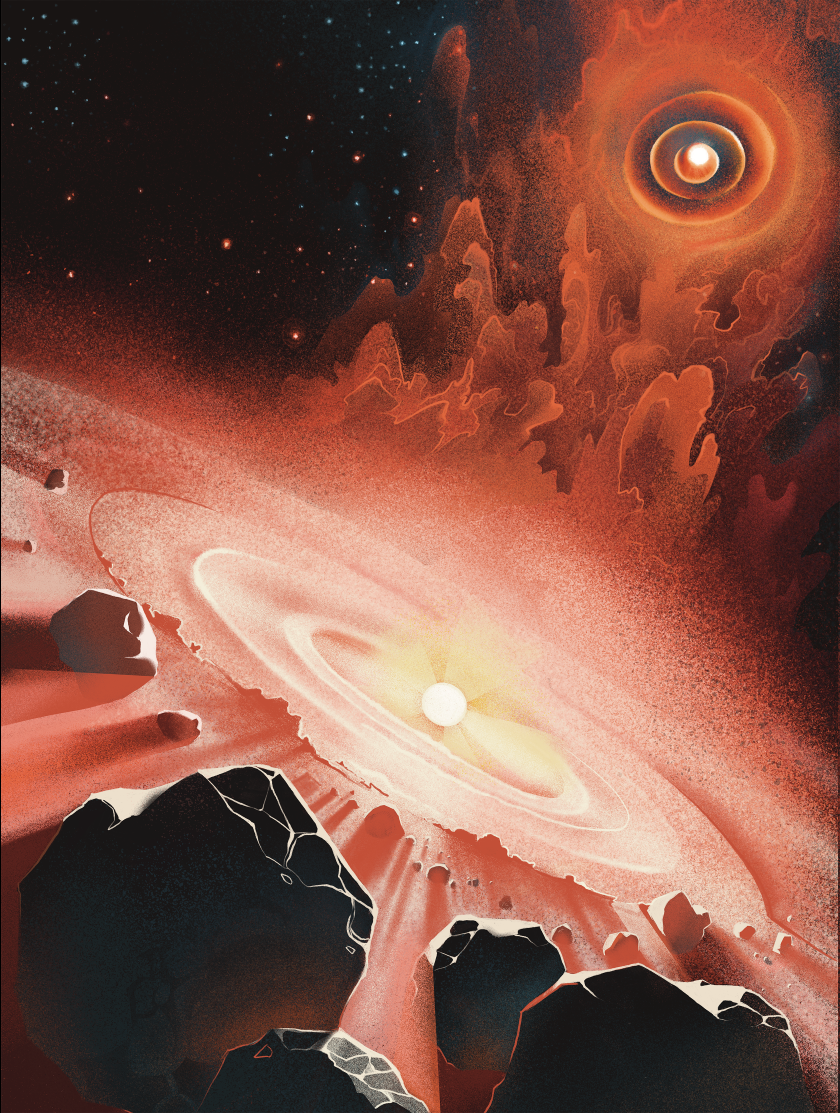.jpg)
An international collaboration of scientists including astrophysicists from Konkoly Observatory and the University of Szeged were able to investigate the birth of the Sun today, even if it happened 4.6 billion years ago! First, they succeeded in measuring the decay of fully-ionised thallium ions using the Experimental Storage Ring facility at the GSI/FAIR laboratory in Germany. The result of the experiment then allowed them to calculate how much radioactive lead (205Pb) is produced in stars. Finally, they used the produced 205Pb to derive the Sun’s formation time from the original material in the star-forming region to be most likely between 10 to 20 million years. The results have been published in the journal Nature.
Scientists can investigate the timescale of the formation of our Sun from its progenitor molecular cloud using as clock the decay of long-lived radioactive nuclei produced in stars before the Sun’s formation. Since the birth of the Sun 4.6 billion years ago, these radioactive nuclei have all long decayed but left their imprints as small excess of their decay products detectable in meteorites. The ideal candidate for this dating method is 205Pb, the only radioactive nucleus produced exclusively by neutron captures in stars of intermediate mass, roughly two to four times the mass of the Sun.
On Earth, atoms of 205Pb decay into 205Tl by capturing an atomic electron and converting one of its protons into a neutron. In stars, instead, where temperatures are much higher (up to hundreds of millions of degrees), all the electrons are removed, and the opposite can also happen: 205Tl decays into 205Pb. This is an exceptionally rare decay mode that happens only if the electron produced by transforming a neutron into a proton inside the 205Tl nucleus is captured into one of the atomic orbits of 205Pb. This complex behavior of 205Pb and 205Tl means that the amount of 205Pb produced in stars can be predicted only if we know the rates at which the two nuclei decay into each other as the temperature changes inside the star. The problem is that these decays cannot be measured under normal laboratory conditions because on Earth 205Tl is stable!
To solve this obstacle an ingenious experiment was designed and conducted by an international team of scientists from 37 institutions in 12 countries. The beta decay of 205Tl is only measurable if 205Tl is stripped of all its 81 electrons and kept under these extraordinary conditions for several hours. This is only possible to do at the GSI/FAIR heavy-ion Experimental Storage Ring. “This measurement was already proposed in the 1980s, but it has taken decades of accelerator development and the hard work of many colleagues to bring it to fruition,” says Professor Yury Litvinov of GSI/FAIR, spokesperson of the experiment. “Thanks to this breakthrough experiment, we can now accurately calculate the decay rates of 205Tl and 205Pb in stars,” says Dr. Riccardo Mancino, from the Technical University of Darmstadt and GSI/FAIR.
From there, the effort was taken over by astrophysicists including researchers from the Konkoly Observatory and the University of Szeged, who calculated new stellar models to predict how much 205Pb is ejected by the winds of intermediate-mass stars. “The new decay rates allow us to predict with confidence how much 205Pb was produced in stars and found its way into the gas cloud where our Sun was born” explains Balázs Szányi, PhD student at the University of Szeged. “By comparing with the amount of 205Pb inferred from meteorites, we found the time interval for the formation of the Sun within its stellar nursery to be between relatively long, ten to twenty million years. This is consistent with other radioactive nuclei produced in the same stars. It means that our Sun was born not alone, but in a large stellar family, with many other siblings, which have long ago dispersed and lost each other.” says Dr. Maria Lugaro, researcher at Konkoly Observatory.
“Groundbreaking experimental facilities, interdisciplinary collaboration across nuclear physics and astrophysics research groups all over the world, and a lot of hard work can help us understand nuclear processes inside stars. Our new experiment uncovered the timescale of the events that happened 4.6 billion years ago, leading to the formation of our Sun.” says Guy Leckenby, doctoral student from TRIUMF (Canada) and first author of the publication. The unique possibilities offered by experiments at GSI/FAIR can bring the Universe into the laboratory.
The work was dedicated to deceased colleagues Fritz Bosch, Roberto Gallino, Hans Geissel, Paul Kienle, Fritz Nolden, and Gerald J. Wasserburg, who were supporting this research for several decades.
The article available to read on Nature's site: https://www.nature.com/articles/s41586-024-08130-4

Figure: Radioactive nuclei from giant stars were alive in the Sun's proto-planetary disk. Artist impression credit: Danielle Adams for TRIUMF